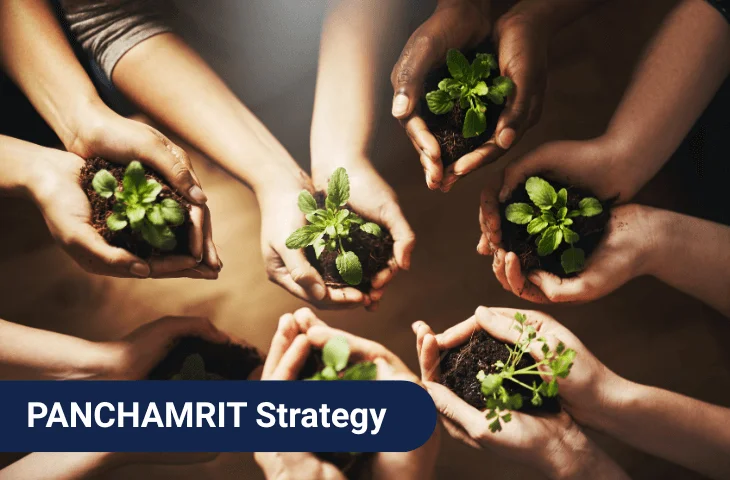The term Panchamrit literally means “five nectars” in Sanskrit. It represents India’s ambitious five-point climate action plan unveiled at the COP26 United Nations Climate Change Conference in Glasgow in November 2021 by Prime Minister Narendra Modi. This strategy is India’s roadmap to balance economic growth with environmental sustainability while addressing the pressing challenges of climate change.
Panchamrit is not just a set of pledges; it is a reflection of India’s commitment to international climate goals, including the Paris Agreement 2015, which aims to limit global temperature rise well below 2°C.
Why did India Announce the Panchamrit Strategy?
India faces a dual challenge: sustaining economic growth while addressing environmental degradation. Over the years, the country has witnessed the impacts of climate change—rising temperatures, erratic rainfall, floods, droughts, and heatwaves affecting agriculture, fisheries, health, and industry. The Panchamrit Strategy aims to:
- Reduce carbon emissions and environmental impact.
- Increase renewable energy capacity and diversify India’s energy mix.
- Enhance global climate leadership by setting ambitious targets.
In simple terms, Panchamrit reflects India’s long-term vision of a green, sustainable, and resilient economy.
What are the 5 Key Commitments of the Panchamrit Strategy?
The Panchamrit Strategy comprises five nectar elements, which together form a roadmap for India’s climate action:
1. Achieving 500 GW of Non-Fossil Fuel Energy Capacity by 2030
India has pledged to increase its energy generation from non-fossil fuel sources such as solar, wind, hydro, and nuclear energy. This involves:
- Investing in renewable energy infrastructure.
- Reducing dependency on coal and fossil fuels.
- Enhancing energy security and self-sufficiency.
Achieving 500 GW of non-fossil energy will help India transition towards cleaner energy while creating jobs in the renewable sector.
2. Ensuring 50% of Energy Needs from Renewable Sources by 2030
India aims to meet half of its total energy requirements from renewable energy sources. This will require:
- Large-scale development of solar parks, wind farms, and hydroelectric projects.
- Upgrading energy transmission and storage infrastructure.
- Promoting energy efficiency and green technology adoption.
This commitment is crucial to reduce carbon emissions and stabilize energy costs while ensuring sustainable development.
Also Check: List of Government Schemes of India
3. Reducing Projected Carbon Emissions by 1 Billion Tons by 2030
India pledges to cut total projected carbon emissions by one billion tons by 2030. The reduction will come from:
- Transitioning to clean energy technologies.
- Increasing carbon sinks through afforestation and reforestation.
- Promoting energy efficiency in industry, transport, and households.
This step reflects India’s determination to mitigate climate change impacts globally while sustaining economic growth.
4. Reducing Carbon Intensity of GDP by 45% by 2030
Carbon intensity refers to the amount of carbon emissions produced per unit of economic output. India aims to reduce its GDP carbon intensity by 45% by 2030, compared to 2005 levels. This involves:
- Promoting low-carbon industries.
- Enhancing energy efficiency in manufacturing, transport, and urban infrastructure.
- Encouraging green investments and sustainable business practices.
Lowering carbon intensity is essential to decouple economic growth from environmental harm.
5. Achieving Net-Zero Emissions by 2070
The long-term goal of Panchamrit is net-zero carbon emissions by 2070, meaning India will balance emissions with carbon removals. This can be achieved through:
- Expanding forests and green cover.
- Promoting carbon capture and storage technologies.
- Encouraging sustainable urban planning and clean transportation systems.
Net-zero emissions are crucial for limiting global warming and fulfilling India’s international climate commitments.
Check Out: Complete List of Important Schemes for NABARD Grade A Exam
What is the Significance of the Panchamrit Strategy?
The Panchamrit Strategy is significant at national and international levels:
| Aspect | Details |
| Global Leadership | India has set bold climate targets, positioning itself as a responsible global actor in the fight against climate change. It sets an example for other developing nations facing similar challenges. |
| Energy Security | Transition to renewable energy reduces dependence on imported fossil fuels, mitigates price volatility, and strengthens energy independence. |
| Economic Growth | Investments in renewable energy and green technologies are expected to: Create new employment opportunitiesFoster innovation in clean energy sectors Attract international green finance |
| Environmental Sustainability | Increasing renewable energy and reducing emissions help combat air pollution, conserve biodiversity, and reduce climate-induced disasters. |
| Social Benefits | Cleaner energy and reduced pollution improve public health, especially in urban areas, while supporting livelihoods in rural and renewable energy sectors. |
What Challenges does India Face in Implementing Panchamrit?
Despite its ambitious targets, India must overcome several hurdles:
- Financial Constraints: Huge investments; mobilizing domestic & international finance is challenging.
- Technological Barriers: Need advanced tech, infrastructure upgrades, and R&D.
- Policy & Governance: Policies must align with economy & society; require coordination across government levels.
- Socio-Economic Impacts: Job disruption in fossil fuel sectors; equity for affected communities needed.
- International Cooperation: Need tech transfer, climate finance, and active global collaboration.
Get ready to crack government job exams with leading educators
How does Climate Change Impact India’s Economy?
Climate change affects both supply and demand sides of India’s economy, with significant implications for agriculture, industry, health, and infrastructure:
- Agriculture: Erratic rainfall, floods, and droughts reduce crop yields, affecting rural livelihoods and food inflation.
- Fisheries: Rising sea temperatures shift fish distribution, impacting fishermen’s income.
- Health: Increased heat stress, malaria, dengue, and respiratory diseases raise healthcare costs and reduce labour productivity.
- Infrastructure: Floods, storms, and heat waves damage roads, railways, ports, and power plants, increasing maintenance costs.
- Industry: Operational costs rise due to climate events and compliance with new climate-friendly regulations.
- Energy: Rising temperatures increase energy demand for cooling, straining supply.
- Financial Services: Climate risks increase credit and insurance risks, affecting banks, businesses, and the economy.
Key Takeaways
| Aspect | Details |
| Panchamrit Meaning | Five nectar elements symbolizing India’s five-point climate action plan |
| Announcement | COP26, Glasgow, November 2021 |
| Targets by 2030 | 500 GW non-fossil energy, 50% renewable energy, reduce 1 billion tonnes carbon emissions, reduce carbon intensity by 45% |
| Long-term Goal | Achieve net-zero emissions by 2070 |
| Significance | Global leadership, energy security, economic growth, environmental sustainability, social benefits |
| Challenges | Financial constraints, technology gaps, policy coordination, socio-economic impacts, international cooperation |
| Additional Measures | Carbon sequestration, climate resilience, green transport, climate-smart agriculture, research & innovation, global cooperation |
Questions Based on Panchamrit Strategy
- What does the term Panchamrit mean in the context of India’s climate action?
a) Five-year plan
b) Five nectar elements
c) Five industrial policies
d) Five renewable projects
e) Five global agreements - By which year does India aim to achieve net-zero emissions under the Panchamrit Strategy?
a) 2030
b) 2045
c) 2070
d) 2050
e) 2060 - What is India’s non-fossil fuel energy capacity target by 2030?
a) 100 GW
b) 250 GW
c) 500 GW
d) 750 GW
e) 1000 GW - By 2030, what percentage of India’s energy needs should come from renewable sources?
a) 25%
b) 40%
c) 50%
d) 60%
e) 75% - How much reduction in projected carbon emissions is India targeting by 2030?
a) 0.5 billion tons
b) 1 billion tons
c) 2 billion tons
d) 3 billion tons
e) 4 billion tons - By what percentage does India aim to reduce the carbon intensity of its GDP by 2030?
a) 35%
b) 40%
c) 45%
d) 50%
e) 55% - Which international climate agreement aligns with India’s Panchamrit Strategy?
a) Kyoto Protocol
b) Paris Agreement
c) Montreal Protocol
d) Stockholm Convention
e) Copenhagen Accord - Which sector in India is most vulnerable to climate change due to irregular rainfall and floods?
a) Manufacturing
b) Agriculture
c) IT sector
d) Banking
e) Mining - Which of the following is NOT a proposed measure under Panchamrit for achieving net-zero emissions?
a) Carbon capture and storage
b) Expanding forests
c) Increasing fossil fuel dependency
d) Promoting renewable energy
e) Sustainable urban planning - What is one major challenge for implementing the Panchamrit Strategy?
a) Excess funding
b) Technological barriers
c) Too many skilled workers
d) Declining population
e) Surplus renewable resources
Also Read:
Answer Key
| Question No. | Correct Answer |
| 1 | b) Five nectar elements |
| 2 | c) 2070 |
| 3 | c) 500 GW |
| 4 | c) 50% |
| 5 | b) 1 billion tons |
| 6 | c) 45% |
| 7 | b) Paris Agreement |
| 8 | b) Agriculture |
| 9 | c) Increasing fossil fuel dependency |
| 10 | b) Technological barriers |
- MISHTI Scheme, India’s Initiative to Restore Mangrove Ecosystems
- National Green Hydrogen Mission Features, Objectives, and Benefits
- Paramparagat Krishi Vikas Yojana, Transforming India’s Organic Farming
- Mission on Integrated Development of Horticulture NHM and HMNEH
- Swachh Bharat Mission, India’s Journey Towards Cleanliness and Hygiene
- SAGY, A Step Towards Holistic Development of Indian Villages

Hi, I’m Aditi. I work as a Content Writer at Oliveboard, where I have been simplifying exam-related content for the past 4 years. I create clear and easy-to-understand guides for JAIIB, CAIIB, and UGC exams. My work includes breaking down notifications, admit cards, and exam updates, as well as preparing study plans and subject-wise strategies.
My goal is to support working professionals in managing their exam preparation alongside a full-time job and to help them achieve career growth.
